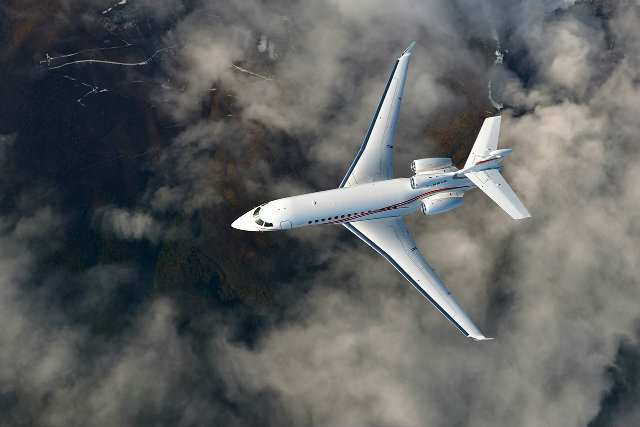French investigators have revealed the first officer of a Dassault Falcon 7X used an escape technique picked up from bombing exercises to regain control of the jet during a trim runaway event on 24 May 2011, which later resulted in the temporary, worldwide grounding of the long-range trijet fleet.
The aircraft’s trimmable horizontal stabiliser moved from its neutral position to 12° down in the space of 15s as the 7X descended through 13,000ft on approach to Kuala Lumpur’s Subang airport.
Although the autopilot initially acted to counter the resulting pitch-up motion, it disengaged after the first 8s. The aircraft’s airspeed began to bleed away from 297kt (550km/h) to 220kt as it pitched to 25° nose-up.
Investigation authority the BEA says the French-speaking first officer, who was flying, realised his attempts to correct the pitch were “ineffective”, but struggled to explain the developing situation to the English-speaking captain.
He instinctively resorted to a bombing manoeuvre learned during his military career when he flew Dassault Mirage IV and Mirage 2000 combat aircraft.

Dassault
The ‘palier-ressource’ manoeuvre involved approaching a target in level flight before pulling up at 30° pitch to release the weapon, and then banking to 90° to reduce pitch and escape at full thrust and low altitude.
After a few seconds of dual input, with the 7X captain initially opposing the extreme 98° right bank, the first officer took priority control and maintained the bank at 40-80° for about 20s. This reflexive correction successfully reduced the pitch from 41° nose-up to 10° and brought the angle-of-attack down to 5°. The jet’s airspeed fell to 150kt during the upset.
The BEA says the aircraft entered a second period of unstable flight about 1min later – slightly less extreme than the first, although the pitch increased to 30° and the airspeed slipped to just 125kt as the jet climbed to 22,500ft.
As the pilots worked to regain control of the aircraft its horizontal stabiliser, for reasons unknown to them, moved back into its neutral position and restored pitch control to the crew. The pilots continued the approach manually and landed the 7X without further incident.
The BEA says the upset lasted 2min 36s and subjected the aircraft to loads of up to 4.6g. The severity of the event resulted in the worldwide grounding of the 7X fleet two days later, while investigators sought to explain the stabiliser trim runaway.
The inquiry traced the runaway to an undetected defective solder joint in the horizontal stabiliser electronic control unit, which caused the system to transmit erroneous signals to the stabiliser.
The BEA has credited the first officer for his rapid improvisation in recovering the aircraft – registration HB-JFN – and praised the level of co-ordination and resource management achieved by the crew in the face of the unexpected upset.
European safety regulators approved a modification to the 7X about a month after the grounding, enabling the type to return to operational status.
Source: Flight International
















